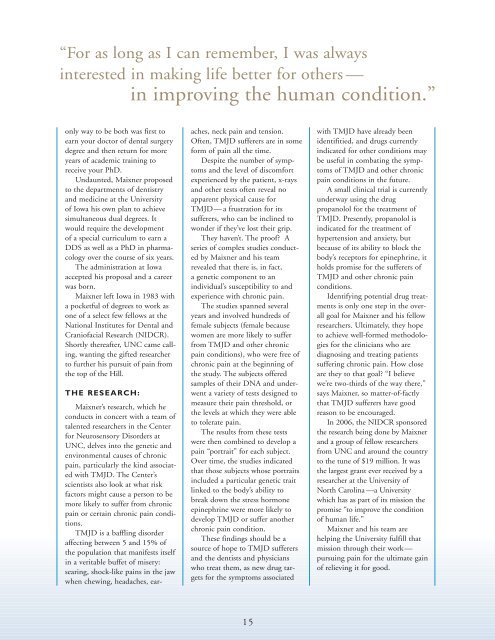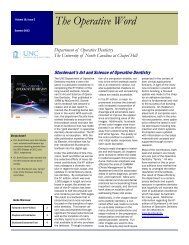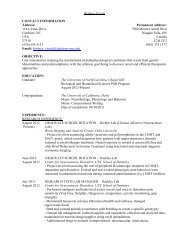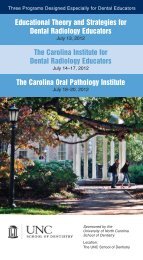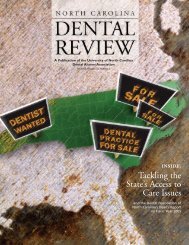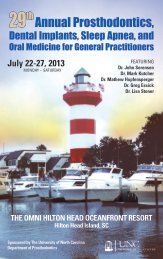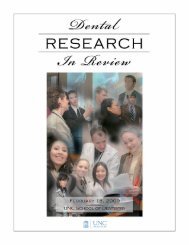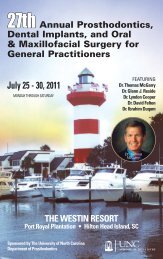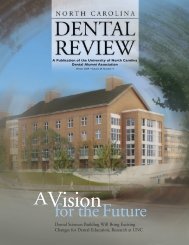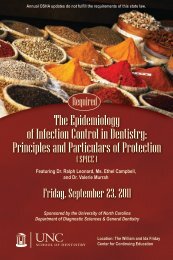Spring 2007 - UNC School of Dentistry - The University of North ...
Spring 2007 - UNC School of Dentistry - The University of North ...
Spring 2007 - UNC School of Dentistry - The University of North ...
Create successful ePaper yourself
Turn your PDF publications into a flip-book with our unique Google optimized e-Paper software.
“For as long as I can remember, I was always<br />
interested in making life better for others —<br />
in improving the human condition.”<br />
only way to be both was first to<br />
earn your doctor <strong>of</strong> dental surgery<br />
degree and then return for more<br />
years <strong>of</strong> academic training to<br />
receive your PhD.<br />
Undaunted, Maixner proposed<br />
to the departments <strong>of</strong> dentistry<br />
and medicine at the <strong>University</strong><br />
<strong>of</strong> Iowa his own plan to achieve<br />
simultaneous dual degrees. It<br />
would require the development<br />
<strong>of</strong> a special curriculum to earn a<br />
DDS as well as a PhD in pharmacology<br />
over the course <strong>of</strong> six years.<br />
<strong>The</strong> administration at Iowa<br />
accepted his proposal and a career<br />
was born.<br />
Maixner left Iowa in 1983 with<br />
a pocketful <strong>of</strong> degrees to work as<br />
one <strong>of</strong> a select few fellows at the<br />
National Institutes for Dental and<br />
Crani<strong>of</strong>acial Research (NIDCR).<br />
Shortly thereafter, <strong>UNC</strong> came calling,<br />
wanting the gifted researcher<br />
to further his pursuit <strong>of</strong> pain from<br />
the top <strong>of</strong> the Hill.<br />
THE RESEARCH:<br />
Maixner’s research, which he<br />
conducts in concert with a team <strong>of</strong><br />
talented researchers in the Center<br />
for Neurosensory Disorders at<br />
<strong>UNC</strong>, delves into the genetic and<br />
environmental causes <strong>of</strong> chronic<br />
pain, particularly the kind associated<br />
with TMJD. <strong>The</strong> Center’s<br />
scientists also look at what risk<br />
factors might cause a person to be<br />
more likely to suffer from chronic<br />
pain or certain chronic pain conditions.<br />
TMJD is a baffling disorder<br />
affecting between 5 and 15% <strong>of</strong><br />
the population that manifests itself<br />
in a veritable buffet <strong>of</strong> misery:<br />
searing, shock-like pains in the jaw<br />
when chewing, headaches, earaches,<br />
neck pain and tension.<br />
Often, TMJD sufferers are in some<br />
form <strong>of</strong> pain all the time.<br />
Despite the number <strong>of</strong> symptoms<br />
and the level <strong>of</strong> discomfort<br />
experienced by the patient, x-rays<br />
and other tests <strong>of</strong>ten reveal no<br />
apparent physical cause for<br />
TMJD— a frustration for its<br />
sufferers, who can be inclined to<br />
wonder if they’ve lost their grip.<br />
<strong>The</strong>y haven’t. <strong>The</strong> pro<strong>of</strong> A<br />
series <strong>of</strong> complex studies conducted<br />
by Maixner and his team<br />
revealed that there is, in fact,<br />
a genetic component to an<br />
individual’s susceptibility to and<br />
experience with chronic pain.<br />
<strong>The</strong> studies spanned several<br />
years and involved hundreds <strong>of</strong><br />
female subjects (female because<br />
women are more likely to suffer<br />
from TMJD and other chronic<br />
pain conditions), who were free <strong>of</strong><br />
chronic pain at the beginning <strong>of</strong><br />
the study. <strong>The</strong> subjects <strong>of</strong>fered<br />
samples <strong>of</strong> their DNA and underwent<br />
a variety <strong>of</strong> tests designed to<br />
measure their pain threshold, or<br />
the levels at which they were able<br />
to tolerate pain.<br />
<strong>The</strong> results from these tests<br />
were then combined to develop a<br />
pain “portrait” for each subject.<br />
Over time, the studies indicated<br />
that those subjects whose portraits<br />
included a particular genetic trait<br />
linked to the body’s ability to<br />
break down the stress hormone<br />
epinephrine were more likely to<br />
develop TMJD or suffer another<br />
chronic pain condition.<br />
<strong>The</strong>se findings should be a<br />
source <strong>of</strong> hope to TMJD sufferers<br />
and the dentists and physicians<br />
who treat them, as new drug targets<br />
for the symptoms associated<br />
with TMJD have already been<br />
identifitied, and drugs currently<br />
indicated for other conditions may<br />
be useful in combating the symptoms<br />
<strong>of</strong> TMJD and other chronic<br />
pain conditions in the future.<br />
A small clinical trial is currently<br />
underway using the drug<br />
propanolol for the treatment <strong>of</strong><br />
TMJD. Presently, propanolol is<br />
indicated for the treatment <strong>of</strong><br />
hypertension and anxiety, but<br />
because <strong>of</strong> its ability to block the<br />
body’s receptors for epinephrine, it<br />
holds promise for the sufferers <strong>of</strong><br />
TMJD and other chronic pain<br />
conditions.<br />
Identifying potential drug treatments<br />
is only one step in the overall<br />
goal for Maixner and his fellow<br />
researchers. Ultimately, they hope<br />
to achieve well-formed methodologies<br />
for the clinicians who are<br />
diagnosing and treating patients<br />
suffering chronic pain. How close<br />
are they to that goal “I believe<br />
we’re two-thirds <strong>of</strong> the way there,”<br />
says Maixner, so matter-<strong>of</strong>-factly<br />
that TMJD sufferers have good<br />
reason to be encouraged.<br />
In 2006, the NIDCR sponsored<br />
the research being done by Maixner<br />
and a group <strong>of</strong> fellow researchers<br />
from <strong>UNC</strong> and around the country<br />
to the tune <strong>of</strong> $19 million. It was<br />
the largest grant ever received by a<br />
researcher at the <strong>University</strong> <strong>of</strong><br />
<strong>North</strong> Carolina —a <strong>University</strong><br />
which has as part <strong>of</strong> its mission the<br />
promise “to improve the condition<br />
<strong>of</strong> human life.”<br />
Maixner and his team are<br />
helping the <strong>University</strong> fulfill that<br />
mission through their work—<br />
pursuing pain for the ultimate gain<br />
<strong>of</strong> relieving it for good.<br />
15


